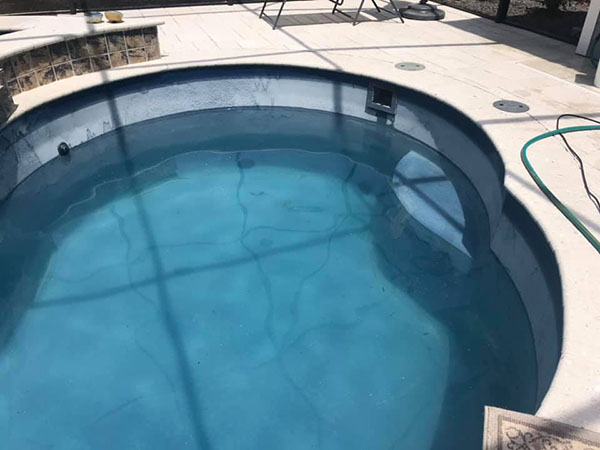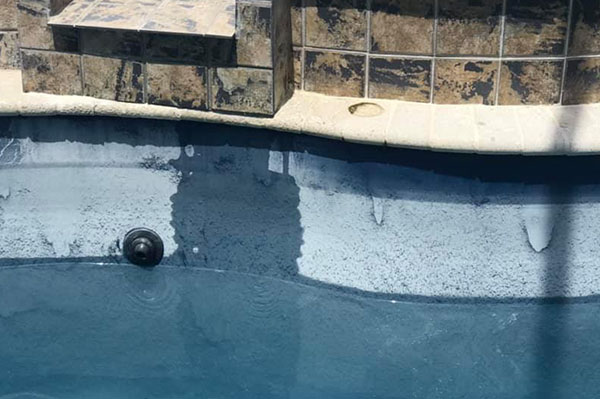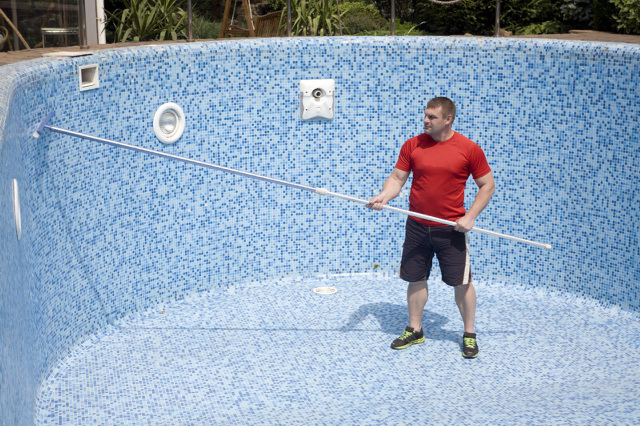Perhaps you’ve recently used your pool and noticed some of your pool tiles turning white near the waterline, and so you’re wondering how to clear that calcium that’s been deposited there. In this article, I’ll be showing you the causes of calcium buildup, as well as all the methods you can use to remove it.
If you have calcium carbonate deposits, you can add either a stain remover, a mild acid, or muriatic acid to the area and scrub it off. If you have calcium silicate instead, the only two viable options are to scrub using a pumice stone or to call a professional.
Before we move on to removing the calcium deposits, let’s first take a look at what they are in particular so that the removal processes we’ll discuss later on make sense.

Article Contents
What is Calcium Scaling?
Calcium scaling is where the calcium is built up and deposited onto your pool floor and tiles (near the waterline).
It’s a slow accumulation and it’s found in areas that have lots of wet and dry cycles. Like the waterline, or the spillway of a spa or water feature.
There are two types of calcium that can cause this: calcium carbonate and calcium silicate (the latter otherwise known as hard calcium). To tell the difference between the two, add a drop of muriatic acid to it; if it foams, you have calcium carbonate, otherwise, it’s calcium silicate.
What is Calcium Carbonate?
Calcium carbonate is the more common culprit of calcium scaling on pool tiles. It’s also the easier of the two to remove. Most of the pool tile calcium removal options we’ll tackle in this article are relevant to calcium carbonate.
What is Calcium Silicate?
Calcium silicate is the less common but more troublesome of the two types of calcium found on pool tiles. Calcium silicate takes longer to build up, but once it’s there, it can be extremely difficult to remove and can enter your pool’s filtration system as well.
What Causes Calcium Scaling on Pool Tiles
The main causes of calcium scaling in pools include:
- High alkalinity
- High pH
- High water temperatures
- High calcium levels (either due to hard water or adding too much calcium to the pool)
You can tell how susceptible your pool is to calcium scaling by looking at its material, where the more porous it is, the more susceptible it is to scale. Thus, something like a concrete pool would be more vulnerable than a vinyl liner or fiberglass pool.
Related Reading: How to Lower Alkalinity | Pool Alkalinity High

Scale Removal Process for Pool Tiles
Here’s a summary of the method to remove calcium scale (white buildup) from pool tiles and pool surfaces.
- Lower pool water level below the buildup
- Use abrasives, scraping tools, or scrubbers to remove calcium
- Spray with calcium-dissolving chemical
- Use abrasives and scrub again
- Repeat until the calcium has been fully cleaned off the tiles
The above is the basic method, now here are the specific tools and chemicals that will help you clean your pool tiles.
Tools to Remove Calcium from Pool Tiles
Usually, it’s best to start by scrapping off as much calcium as you can with an abrasive tool. You want to be careful that you don’t scratch your pool tiles or pool surface though. Some products can also take the shine off tiles.
Make sure you test a small area first and wait for the tile to dry before using abrasive tools.
Here is a general list of the tools that can be used to remove calcium deposits:
Wet & Dry Sand Paper: if you’re looking for a natural, chemical-free way to remove calcium from pool tiles, fine grit sandpaper, like 3000 grit, will remove calcium buildup. It can be very slow-going and hard work, though. It may also take the shine off some tiles. So test a small area first.
You may find that some of the other scrubbing methods and calcium-dissolving chemicals are much faster to apply.
Pumice Stone: Used to scrub the deposits away. Make sure to wet both the stone and the surface before usage, as the rough surfaces of the stone can easily scratch or otherwise damage the pool surface. Pumice stones should be used on tile and concrete surfaces only and not on soft pool surfaces (like vinyl) as they will easily tear the material. Here’s a product we can recommend:
- Removes lime, calcium, scale build-up
- Safe for most pool surfaces
- Non-toxic and chemical free
Nylon Brush Cups: You can use a cordless drill and a nylon bristle brush cup/wheel to similarly scrub the deposits away. Make sure to avoid steel cups or wheels as this can lead to rust on the bottom and tiles of the pool.
- Abrasive filament nylon bristle cup brush
- With a drill adapter arbor
- Leaves the surface with a fine enough scuff scratch
Scraper: Using a scraping tool can help to remove calcium from pool tiles. Be careful with a tool like this as it can scratch some softer tiles. Test a small section first. You can use a scraper like this:
- A 10 in 1 easy-to-use tool
- Rust-resistant steel blade
- Scrapes paint, calcium deposits & gunk from tiles
Pressure Washer: This can be used as a last-ditch effort to remove the hardest calcium deposits (including calcium silicate). A pressure washer blasts water up to 2500 PSI at the deposits to quickly remove all but the hardest deposits. You’ll have to be careful though as the pressure of the water can weaken or damage the pool tiles if it’s turned up too high
Related Reading: How to Replace Loose, Cracked, or Broken Pool Tiles
Chemicals to Remove Calcium
There are many products and chemicals available to help remove calcium scaling. Using a chemical alone will probably not be enough to remove a bad case of scale. Some manual scrubbing will also be required. Saying that chemicals will make scale and calcium removal much easier.
Here are some of the most commonly used chemicals to remove calcium deposits.
1. Using Muriatic Acid to Dissolve the Deposits
Muriatic acid is a strong acid that is typically used to rapidly lower the pH of water, but it can also react with and dissolve hard calcium. You can get such product here:
- Controls the pH level of water in swimming pools & hot tubs
- Brightens concrete & masonry surfaces
- Reduces up to 90% of harmful vapors
Muriatic acid will break down the calcium to the point where you can scrub it away easily with a scouring pad. Its major downside is that it’s a highly acidic chemical that can cause serious injury if not handled properly.
You also need to be careful not to spill too much in the water, or you will lower the pH.
How to Use Muriatic Acid to Remove Calcium Deposits from Pool Tiles
Here are the specific instructions for using muriatic acid. Keep in mind that you should always follow the manufacturer’s instructions if available.
The materials you’ll need include:
- Muriatic acid
- Plastic bucket, measuring cup, stirring spoon, spray bottle
- Scouring pad
- Goggles
- Rubber gloves
- Chemical apron
- Respirator
- Start by using a scrapper or abrasive pad to remove as much calcium as possible. Some tiles are softer than others and scratch easily. So use the most appropriate tool for your tiles.
- Put on your protective gear and take all the materials outside
- Fill your bucket with a gallon of water and measure out 8 oz of muriatic acid
- Add the muriatic acid to the water slowly to avoid splashing
- Gently stir using the plastic stirring spoon
- Carefully pour the mixture into the spray bottle
- Spray some of it onto the calcium deposit(s) and wait a minute or two for it to react
- Scrub the area with the scouring pad. You may need multiple applications to remove it
- Test the water and make sure the pH is at normal levels before entering the pool
2. Stain Removers/Stain Erasers/Calcium Removers
There are many stain removers (otherwise known as stain erasers or calcium removers) on the market that are designed to remove calcium carbonate.
Typically, these removers will require you to scrub or scrap off the outermost layer of the deposit, then add the remover and scrub each layer underneath until it’s all gone. Sometimes several applications are required. Here’s a good calcium release product to remove stains:
- Non-toxic spray
- Does not affect water pH and won’t etch most surfaces
- Quickly remove heavy calcium and mineral deposits
3. Calcium Scaling Treatments that Can Dissolve Deposits
Pool stores often carry particular calcium scaling treatments that, unlike muriatic acid or stain removers, take their time dissolving the calcium deposits over a period of several weeks.
Though simple to use (all you have to do is add them to the pool water) and work for a variety of pools, they can take months to fully dissolve calcium silicate (aka hard calcium), making calcium scaling treatments, not the most viable option if you’re in a rush.
Related Reading: What Is Muriatic Acid for in a Pool?

Natural Ways to Remove Calcium from Pool Tiles
Besides the chemicals we’ve looked at previously, there are several natural ways to clear the calcium using materials you probably have at home. Keep in mind that these will usually only work for calcium carbonate deposits, as calcium silicate will be too stubborn to be scrubbed off with common household items.
1. Using Vinegar to Clean Pool Tiles
One of the most popular household items you can use to dissolve deposits is vinegar. Vinegar is a good option because it’s non-toxic, inexpensive, and can clean a variety of surfaces.
All that’s required is for you to get a spray bottle and fill it with a mixture of vinegar and water. Then, just grab a stiff abrasive brush or scrapper, and begin to spray and scrub at the deposits.
2. Using Vinegar and Baking Soda to Clean Pool Tiles
A somewhat more effective way of removing calcium deposits is through the combined use of vinegar (especially white vinegar) and baking soda. This combination will do a better job of softening the calcium deposits than vinegar alone. Here are the steps:
- Using a scrapper, abrasive pad, or stiff brush, start by scrubbing off as much of the initial scum as you can
- Make a mixture of vinegar and baking soda in a two-to-one ratio
- Rub the mixture onto all surfaces affected by the calcium scaling
- Leave the mixture on for about five minutes to allow it to soften the deposits
- Wipe or scrub off the paste
3. Other Natural Ways to Remove Calcium Deposits
There are several other natural methods of removing calcium deposits using common household items such as:
- toothpaste
- borax
- hard work
However, they may not be as effective as the methods described previously. The methodology is the same, where you apply the product onto the calcium deposits, wait a few minutes for any reactions to take place, then scrub the resulting mixture away using some type of brush, pumice stone, or wet/dry sandpaper.
Going the Professional Way
Using Magnesium Sulfate to Blast off the Deposits
Magnesium sulfate is a chemical compound that appears as small, colorless crystals and is used for a variety of purposes, including as an anticonvulsant. In our case, magnesium sulfate is commonly used by professional pool companies as a medium to blast off calcium deposits, a process known as bead blasting or pressure washing.
Though the name is identical, this method differs from the use of a typical pressure washer (as described above) in that, instead of blasting water, the professionals would use a specialized compressor to blast solid materials, such as magnesium sulfate, beads, or sand at the pool tile. This allows the deposits, no matter how hard, to be scraped off easily and will save you tons of time from having to scrub at the tiles yourself.
The one downside to this method is the cost and the mess. Hiring a professional over and removing the deposits for you will be costlier than for you to do it yourself. However, if you find yourself in a dilemma involving calcium silicate, especially if it’s already in the pipes and filtration system, this may be your only choice.
Tips to Prevent Calcium Scaling
Now that we’ve gone over all the methods of removing calcium deposits, here are some tips you should keep in mind to avoid calcium scaling from reoccurring.
- Make sure the pH of your pool water is at its optimal level as high pH has a significant effect on calcium scaling
- Use an automatic pool cover to reduce the chance of water evaporating as the water can leave behind calcium after it evaporates
- Regularly test your pool water to make sure the chemicals are at the correct levels
- Maintain a calcium hardness level of 200-400 ppm
Final Thoughts
Calcium deposits on pool tiles can be an annoying sight to notice. However, there are many ways you can take to resolve the issue, as well as prevent it from reoccurring.






